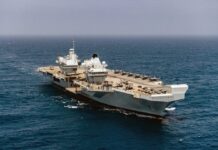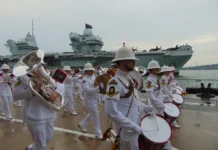
Aircraft of the Royal Navy Since 1908. By David Hobbs. Seaforth Publications, Barnsley, Yorkshire, 2024
Reviewed by Tim Coyle
In 1962, a youthful David Hobbs saved sufficient pocket money to purchase a copy of Aircraft of the Royal Navy since 1912 by Owen Thetford. In those far-off pre-digital years, this was the only authoritative reference of the Royal Navy Fleet Air Arm.
Following his passion, Hobbs went on to serve 33 years as a RN aviator during which he made more than 800 carrier landings and qualified on most fixed and rotary winged aircraft in the FAA inventory. Following this, he spent eight years as Curator and Principal Historian at the FAA Museum, Yeovilton. Since 2006 he has pursued a career as a full-time author and commentator on naval aviation. As such he is justly regarded as the preeminent historian of the FAA; the Australian Naval Institute has reviewed seven of his books and David is well known to ANI members for his many excellent book reviews on naval and wider maritime subjects.
In Aircraft of the Royal Navy Since 1908 we have a definitive analysis of 422 aircraft types (Thetford only had 244) manufactured by 92 entities; the book is a culmination of over 40 years of research. A feature of the book is the author’s comments of his personal operational experience in flying the aircraft to which are added observations by contemporary aircrew gathered during his term as FAA Museum Curator. Most prominent of these is Captain Eric ‘Winkle’ Brown, the legendary RN Test pilot. Presented in a handsome large format hardback, the book’s 368 pages are liberally adorned with high quality images of the aircraft in the operational environment, many of which depict flight deck action. Most of the images are from the author’s collection; specially commissioned three view drawings accompany the aircraft entries.
The format is a strict alphabetical order of the manufacturers and designers’ original names without references to subsequent corporate amalgamations. The aircraft are shown in chronological order within the company listings. Older readers always refer to them as products of their initial producers; for example, the Blackburn Buccaneer is always referred to as such, rather than as part of the Hawker-Siddeley Group, and latterly, British Aerospace. The numerous American types, operated by the FAA mainly in the British Pacic Fleet, are shown as products of their US manufacturers.
No details are spared; a typical example is the Fairey Gannet, an aircraft flown operationally by the author. Ten heavily illustrated pages contain not only full details of the Gannet variants and David’s observations of the type, but also those of the Observers accommodated in an ‘analogue cave’ aft of the pilot in an enclosed station replete with a wall of fearsome screens and consoles in the Gannet AEW 3.
Observers appear to have suffered a distinct lack of exposure to the natural environment in the later types. The De Havilland Sea Vixen had the pilot’s station offset to port with normal access via a canopy. The Observer, however, entered the aircraft via a hatch to starboard and slightly behind the pilot. His window on the world was a small port – but the jet-age Observer wasn’t meant to observe and plot on a chart.
Rather it was the halcyon days of the 1920s and 30s in which the serious business of visual observing and reporting as scouts for the Battle Fleet that Observers plied their trade. To our sophisticated 21st century eyes, the Avro Bison of the 1920s looks like it could only be loved by a manufacturer which had just landed a major contract. But it was an eminently sensible design – to quote Hobb’s description: its ‘central portion formed a plywood observer’s cabin which had sufficient space for the aircrew to stand, move about and make use of large rectangular observation windows at either side to plot enemy warships on a chart fitted to a central plotting table’. The aeronautical Bison featured a bulbous fore end on top of which the pilot sat. He entered the cockpit via a fixed access ladder.
The Blackburn Blackburn was similar in configuration and appearance and answered the same Specification as the Bison. The name Blackburn attached to the manufacturer of the same name probably might have puzzled some, however we are told it was named in accordance with contemporary British naming policy of towns and hence the ‘imaginative’ name (one can’t help but imagine it was a ‘tongue-in-cheek’ nod to the policy).
Of course, in a definitive compendium such as Aircraft of the Royal Navy, the experimental designs – largely unsuccessful or not pursued – add to the overall interest of the work. Some examples include the Avro Fleet Shadower of 1937. Powered by four mighty 130 hp Pobjoy engines, the Shadower was to fly at 38 knots for up to six hours to shadow enemy forces. The pilot sat high in the fuselage while the Observer luxuriated in a glazed compartment under the pilot with the Telegraphist accommodated aft. Sadly, only one was completed.
The 1949 innovative rubber deck landing experiment was based on the concept of deleting the aircraft’s landing gear, thus saving weight, and landing on a flexible rubber deck. Three Sea Vampires carried out over 200 deck landings on two modified carriers. The obvious disadvantages included movement of the landed aircraft from the flight deck by crane with consequent unacceptable delays to operations.
My favourite aircraft name is the Bognor Bloater. To the uninitiated, this might be imagined to be a type of meat pie sold off the fun pier at Bognor Regis. Not so; it was a 1915 design of the White and Thompson company. Conventional in appearance, only a handful were produced and proved unpopular in service (the name wouldn’t have helped).
A seamew is a small to medium-sized gull-like bird with a white body and grey wings. The Short Seamew appeared to be as inoffensive as its ornithological namesake. I can dimly recall seeing hopeful advertisements in Flight International magazine for the Seamew which, to me, could surely not hold a candle to the mighty Gannet. Hobbs concludes his coverage of the anaemic Seamew in stating: ‘Seamews only served with 700 NAS for a brief period between the end of 1956 and the beginning of 1957. The Seamew certainly adds weight to the theory that if a requirement specifies cheap mediocrity the result will certainly not be impressive, and it is difficult to understand why development lasted as long as it did’.
Many of the images feature flight deck action typical of the periods. A British Pacific Fleet Seafire is shown on the flight deck of HMS Implacable – its wings being folded by no less than 15 Handlers clothed only in shorts, socks and shoes (Occupational Health and Safety in 1945 was non-existent in the burning Pacific sun). A related image shows a Clear Lower Deck hands-on evolution of pushing a perfectly serviceable TBF Avenger over the side of HMS Pioneer off Sydney in 1945 – the cheapest method of Lend lease postwar disposal.
From early naval dirigibles, through the spindly biplanes of World War One, the interwar period, the progressively more powerful and magnificent piston-engined generation, through the early jets right up to the 21st century’s Lockheed Martin F-35B – they are all given billing in this extraordinary work.
Finally, naval people never forget the sacrosanct terminology of the Service, regardless of which branch in which they have served. With much pleasure one can read the caption to a Sea Vampire image: ‘Sea Vampire T 22, XA 160 in green-and-white paint scheme for use as Flag Officer (Home)’s barge at Lee-on-Solent in 1962’. Naturally, a Flag Officer’s official conveyance is termed a ‘barge’ whether it floats or flies!
David Hobbs’ Aircraft of the Royal Navy Sinc 1908 is a classic work-and and, I suggest, a mandatory addition to any aviation and wider naval library.



